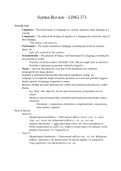Class notes
Review of LING371 Syntax Material
- Course
- Syntax (LING371)
- Institution
- McGill University (Mcgillu)
This is a complete summary of all LING 371 notes, including all the concepts for the problem sets, midterm and final exam. It is a good study guide and provides concept explanations and definitions for various syntax topics.
[Show more]



